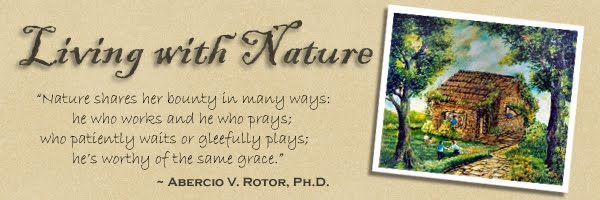Parable of the Five Trees
Dr Abe V Rotor
Parable of the Five Trees in Acrylic by AVR
Trees, like humans, also talk. They talk to one another everyday.
Actually the breeze passing through their leaves carry their conversations and even their songs and messages.
Only that we do not understand what they are saying, so we can only make inferences. For example, the rustling of their leaves and their outstretched branches touching one another, or some trees leaning to get close to others undoubtedly vouch this belief to the level of phenomenon.
The communication of trees runs through a network that enhances the unity and harmony of the ecosystem they form. Sometimes this kind of communication is perceived as queer, unintelligible sounds which made our ancestors believe there are spirits guarding the place like the deity Maria Makiling guarding the forest that is named after her.
Old folks advise us trespassers just to utter reverently "Bari-bari... Or tabi-tabi, po." when going through the forest or thicket.
One day five juvenile narra trees were engaged in a conversation.
Said one, "When I grow up and reach my fate to be cut down, I wish that I be made into a beautiful bed fit only for a king or queen."
The four trees began to have their own wishes, too.
Said the second narra, "I would like to be the mast of the tallest ship that travels fast and wide on the ocean."
Said the third, "I will make a fort, a strong fort, no invader can break through."
The fourth narra tree took some time to think, then said, "I'll be a tower to hold a big bell."
The fifth was the last to speak, but not outwitted. "Oh, in my case I would like to give all my wood to make the biggest temple of worship."
Years and years passed, and the trees finally reached full maturity. The woodsmen came and cut them down.
Guess what happened to the trees. Did all their wishes come true?
The first tree did not become a beautiful bed, but only a manger, actually a feeding trough in a secluded barn.
The second tree did not become part of a tall ship; it was made into a simple boat.
The third tree was not made into a strong fort, only a stem of it the size of a pencil and became a writing tool of sort.
The fourth tree was not made into a belfry, but just one branch of it was made into a fine shepherd's crook.
The fifth tree failed to provide materials to build the largest temple of worship; two limbs were made into a cross.
So when Christ came into this world, he was born on a manger. It was comfortable enough on a wintry night?
When He became a shepherd, He looked for a crook and found a sturdy one to tend His flock of sheep.
As a Preacher He rode on a dinghy on which he delivered his sermons and told parables before the throng along the shores of Galilee.
When people were about to stone a sinner to death, He took a stick and wrote something on the ground, and on rising said, "He who has no sin cast the first stone." No one did.
Alas! When Christ was condemned to die, He carried a wooden cross and on it he was crucified. The cross became the symbol of Christianity.
When I went on a pilgrimage to the part of the forest where the five trees once grew, I found nothing but grass. There was complete silence as a beam of light from the sky shone on the spot where I stood. ~
Reflection on the Parable of the Five Trees
Lofty are my dreams soaring far and wide,
In boundless flight to nowhere;
in pursuit of wealth, power and pleasure,
and confidence of a conqueror.
Blind of history, even as it repeats itself,
In short-lived fame and fortune,
Yet models it presents to my ambitions
In glitters, glory and grandeur.
All In youth’s craving, and craving still
To believe dreams ne’er get old;
But time takes toll in dreams unfulfilled,
And fate the judgment on earth.
Beyond lies a second kingdom few
Can grasp – life’s real meaning;
Life’s purpose, stirrings of the soul
To live in others, beyond the self.
How little do I know of the Fisherman,
Born simple, preached love,
wrote justice, searched the lost lamb,
died that humanity may live. ~
avrotor 2013
 Napulinganka?
Napulinganka?

























.jpg)




